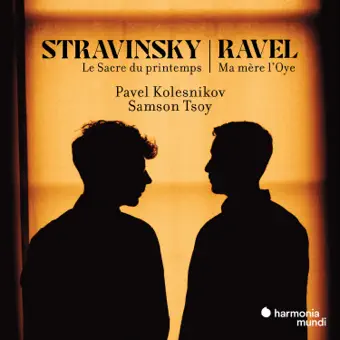juli 2025
Stravinsky: Le Sacre du printemps - Ravel: Ma mère l'Oye
Pavel Kolesnikov & Samson Tsoy
Fascinerend en betoverend, Pavel Kolesnikov en Samson Tsoy pakken het pianoduet van Stravinsky’s Le Sacre du Printemps met overtuigende vaardigheid aan en verkennen het.

De pianoduetversie van The Rite fungeerde oorspronkelijk als een repetitie-instrument. Maar net zoals Stravinsky terecht beweerde dat zijn balletpartituur in de concertzaal zijn mannetje zou staan, zo verdedigen Kolesnikov en Tsoy de pianobewerking als concertstuk.
Daarmee gaan ze veel verder dan een louter getrouwe uitvoering. Dat blijkt meteen uit hun ongewoon stekelige rubato en afgekapte articulatie in de inleiding van deel 1. Zulke dingen zullen misschien niet ieders smaak zijn – ik vermoed dat Stravinsky net zo geschokt zou zijn geweest door Karajans opname van de orkestversie. Maar Kolesnikov en Tsoy houden voet bij stuk. 'The Augurs of Spring' gaat sneller dan welke orkestuitvoering dan ook ooit zou kunnen, en de 'Mock Abduction' is ronduit supersonisch. Wolken van toegevoegd pedaal, een overvloed aan pianissimo subito en aanpassingen zoals een paar heerlijke extra hoge tonen in het 'Ritual of the Ancestors' (die de tamboerijn nabootsen) behoren tot hun talrijke initiatieven. Aanvankelijk sceptisch, genoot ik uiteindelijk van ze allemaal. Of bijna allemaal.
Er zijn een aantal details waar ik kritiek op heb: waarom de ontbrekende tel niet twee maten voor fig. 44 herstellen, bijvoorbeeld, en waarom de percussietikken één maat voor het 'Ritual of the Ancestors' fortissimo spelen terwijl ze piano zijn in de orkestpartituur (Stravinsky vergat simpelweg de markering toe te voegen in de duetversie)? Maar er is zoveel meer in deze onuitputtelijke partituur dat Kolesnikov en Tsoy ons opnieuw laten horen. En wie zegt dat pianisten zich in 1912, tijdens het langdurige repetitieproces voor de Ballets Russes (ervan uitgaande dat ze virtuoos genoeg waren om de muziek überhaupt onder de knie te krijgen) niet soortgelijke vrijheden zouden hebben gepermitteerd? De droge akoestiek vergde wat gewenning, maar ook dat werd uiteindelijk als positief ervaren, omdat het een uitzonderlijke helderheid mogelijk maakte.
De meest opvallende rivalen zijn de hieronder vermelde versies voor twee piano's, dus vergelijkingen zouden niet op een gelijk speelveld liggen. Kolesnikov en Tsoy genereren echter bijna evenveel decibel op hun enkele piano (luister naar hun evocatie van de pauken en de bastrom in de 'Sacrificial Dance'). Het is alsof ze hebben geprobeerd de legendarische Stravinsky-Debussy-uitvoering te herscheppen, waarover de Fransman zei: 'Het achtervolgt me als een prachtige nachtmerrie en ik probeer tevergeefs de angstaanjagende indruk die het op me maakte, te herbeleven.' En dat lukte.
Aan de andere kant van zoveel opzichten is Ravels Moeder de Gans Suite wederom een klein wonder van pianistische herinterpretatie (in dit geval was het duet feitelijk de oorspronkelijke vorm van het ballet), met zijn schijnbaar oneindige, betoverende nuances van pianissimo. Het album wordt gesierd door twee elegante essays: de ene is Gallisch-fantastisch en toegeschreven aan de pianisten, de andere is solide musicologisch. Hoeveel of weinig pianoduetalbums je ook in je virtuele of fysieke boekenkast wilt hebben staan, ik zou er met moeite een boven deze aanbevelen.

The piano duet version of The Rite originally functioned as a rehearsal tool. But just as Stravinsky rightly claimed that his ballet score would stand up for itself in the concert hall, so Kolesnikov and Tsoy vindicate the piano arrangement as a concert piece.
In so doing, they go far beyond a merely faithful realisation. That much is immediately evident from their unusually spiky rubato and clipped articulation in the Introduction to Part 1. Such things may not be to everyone’s taste – I suspect Stravinsky would have been as appalled as he was by Karajan’s recording of the orchestral version. But Kolesnikov and Tsoy stick to their guns. ‘The Augurs of Spring’ goes faster than any orchestral performance ever could, and the ‘Mock Abduction’ is positively supersonic. Clouds of added pedal, an abundance of pianissimo subito and rejiggings such as some delicious added high-treble flicks in the ‘Ritual of the Ancestors’ (emulating the tambourine) are among their numerous initiatives. Initially sceptical, I ended up relishing them all. Or almost all.
There are a number of details to take issue with: why not restore the missing beat two bars before fig 44, for instance, and why play the percussion taps one bar before the ‘Ritual of the Ancestors’ fortissimo when they are piano in the orchestral score (Stravinsky simply forgot to add the marking in the duet version)? But there is so much else in this inexhaustible score that Kolesnikov and Tsoy make us hear afresh. And who’s to say that pianists might not have taken similar liberties in 1912 during the protracted rehearsal process for the Ballets Russes (assuming they were virtuosic enough to get their fingers round the music in the first place)? The dry acoustic took me some adjustment, but this too eventually registered as positive, since it enables exceptional clarity.
The most outstanding rivals are the two‑piano versions listed below, so comparisons would not be on a level playing field. That said, Kolesnikov and Tsoy generate almost as many decibels on their single piano (hear their evocation of the timpani and bass drum in the ‘Sacrificial Dance’). It is as though they have sought to recreate the legendary Stravinsky-Debussy performance, of which the Frenchman said: ‘It haunts me like a beautiful nightmare and I try in vain to recapture the terrifying impression it made on me.’ Sought and succeeded.
At the other extreme in so many ways, Ravel’s Mother Goose Suite is here another minor miracle of pianistic reimagining (in this case the duet was actually the ballet’s original form), with its seemingly infinite, ravishing shades of pianissimo. The album is graced by two elegant essays: the one Gallic-fanciful and credited to the pianists, the other solidly musicological. However many or few piano duet albums you want on your virtual or actual shelves, I’d struggle to recommend any above this one.
